Outsourced Product Development: How To Succeed In 10 Simple Steps
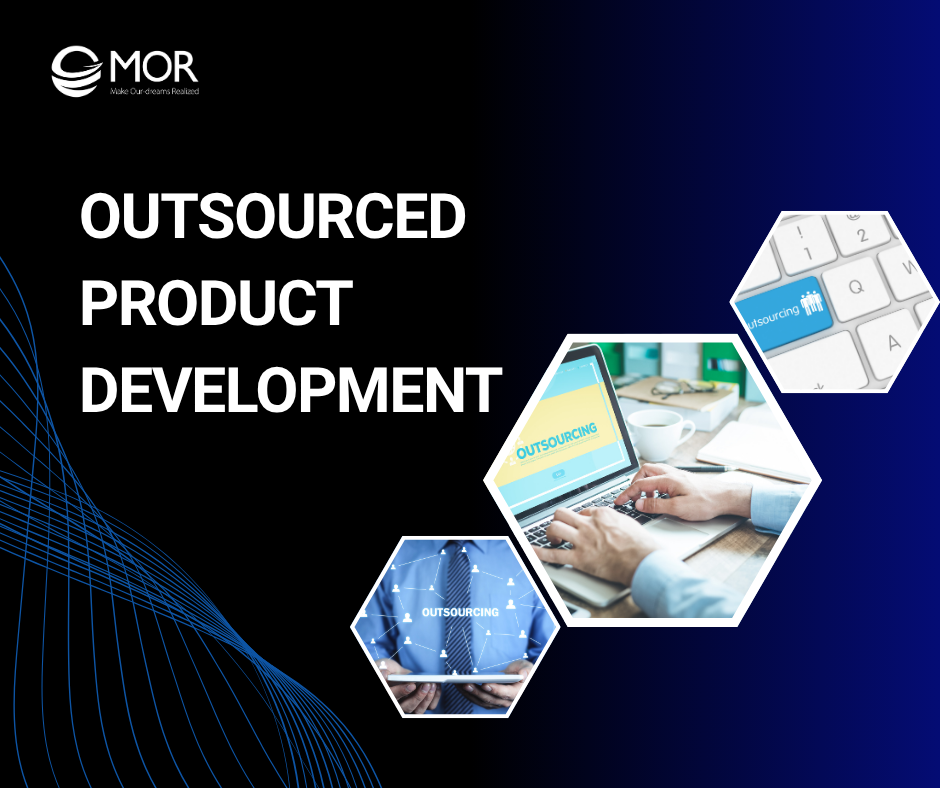
Trying to build something great without overloading your team or blowing your budget outsourced product development might be exactly what you need. It gives you access to global talent, sharp skills, and faster delivery, without the high cost of full-time hiring. But that’s only the start. MOR Software’ll walk you through the real advantages, when outsourcing makes sense, which projects to delegate, and how to choose the right partner to get it done right.
What Is Outsourced Product Development?
Outsourced product development means working with an external team to plan, build, or maintain your software product. This can include every phase, from research and UI design to backend engineering and ongoing support, or just the specific parts where you need help.
Let’s say you’re developing a mobile app. You might handle the feature development internally but bring in a third-party team for the interface design or QA testing. Or you could hand off the full build to an offshore partner while your internal staff handles business logic and user validation.
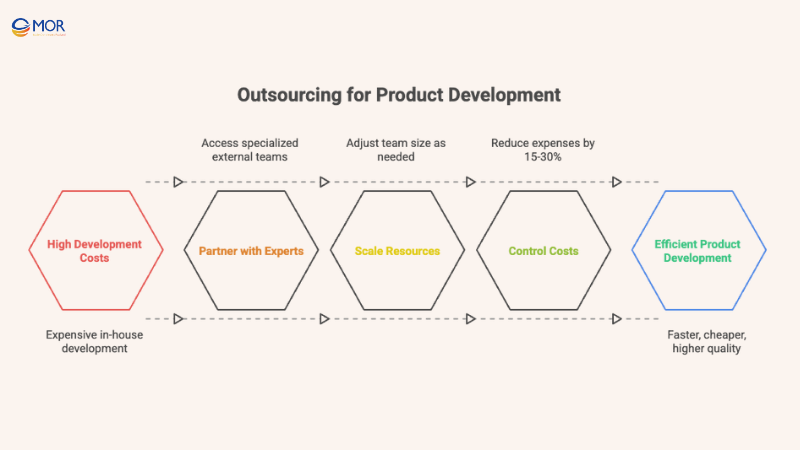
This model gives you access to skilled developers, designers, and testers across borders without the overhead of full-time hires. Businesses report average cost savings of 15–30% through outsourcing software development. It’s a popular choice for companies that want to save time and money without sacrificing quality.
Whether you’re outsourcing product development short-term or long-term, the goal is the same: get your product to market faster while staying focused on what your internal team does best.
Working with outsourced product development companies also allows you to scale as needed. Instead of hiring a new department, you can simply extend your team for a sprint or a full release cycle. It’s one of the smartest ways to stay competitive when building digital products today.
This approach is widely used in product development outsourcing, especially when speed, flexibility, or budget is a concern. Around 76% of companies currently outsource IT functions, including coding, QA, and UX/UI design. This reflects how deeply integrated outsourcing is in modern development workflows.
Main Types of Outsourced Product Development
Outsourced product development can be grouped into three main models based on where your partner is located.
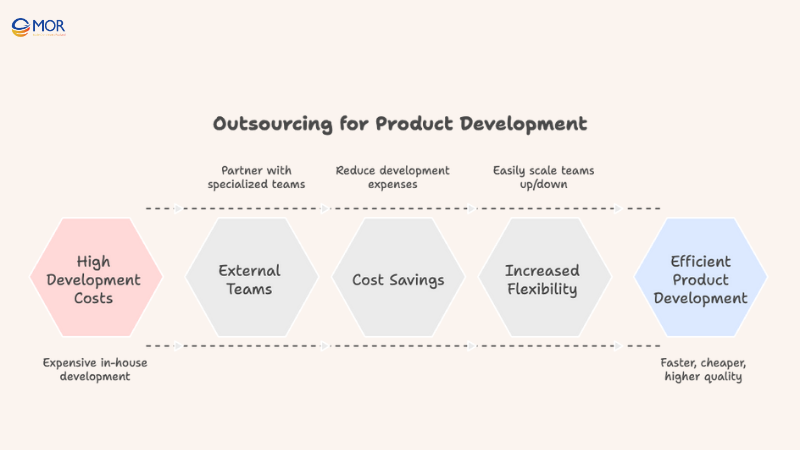
Nearshore Product Development
Nearshore product development means working with a vendor in a nearby country, often just one or two time zones away. This setup makes communication easier and travel cheaper, and the teams usually share similar business practices and culture. While not as cheap as offshore, nearshore software outsourcing is still more affordable than building an in-house team.
Offshore Product Development
This type of development involves partnering with teams in far-off countries. The biggest draw is cost savings. Many businesses turn to offshore providers for access to top tech talent at a fraction of the cost.
That said, you might face time zone delays or language gaps, so project planning needs to be tight. Still, outsourced product development services in countries like Vietnam or India often deliver strong value for global clients.
Onshore Product Development
This development refers to hiring a team within your own country. It’s the easiest in terms of collaboration. You get the benefit of shared language, culture, and work habits. But you’ll likely pay a premium for those conveniences, especially in high-cost regions.
Choosing the right approach depends on your budget, timeline, and how closely you want to work with the team. Many outsourced software product development projects today blend these models, using hybrid setups to balance quality and cost.
Key Benefits of Outsourced Product Development
Outsourced product development gives companies a smarter way to scale, innovate, and stay lean. Compared to building an in-house team, outsourcing comes with seven standout advantages.
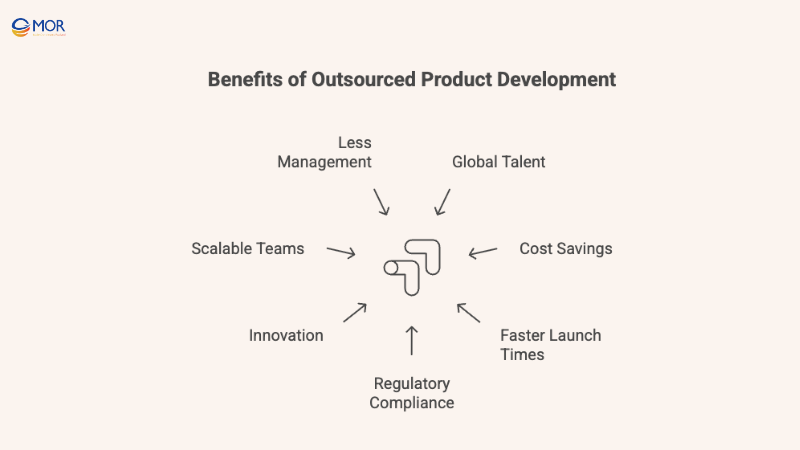
Access to Global Talent
Outsourcing lets you work with skilled professionals from anywhere in the world. Whether you need an AI engineer, UX strategist, or blockchain development outsourcing developer, you're not limited by your local job market.
Let’s say you're eyeing developer outsourcing in Asia. You might find top-tier AI specialists in Vietnam or skilled full-stack developers in the Philippines, without the long hiring process or relocation hassle.
Cost Savings
Hiring full-time staff means covering salaries, training, benefits, and office expenses. That adds up fast.
Outsourcing product development slashes those costs. You pay only for the work you need, when you need it. The savings are even clearer when comparing labor markets. A US company, for instance, might hire a senior product owner around $10,000 –15,000 per year in Vietnam instead of about $120,800 per year in the States.
Many companies now prefer product design and development outsourcing for this reason alone, it frees up budget without lowering standards. And when nearshoring, you get similar time zones and strong talent without the big price tag.
Faster Launch Timelines
One big reason companies choose outsourced product development is speed. External teams already have the skills, tools, and workflows in place. You skip the ramp-up time, avoid training delays, and move faster from concept to release.
Using partners with proven delivery systems means your product reaches users sooner, without sacrificing quality. And if you're working across similar time zones, that pace picks up even more.
Take nearshoring as an example. If your team is in Washington and your vendor is in Ho Chi Minh City, you're almost in sync. That short time difference helps resolve issues quickly, make faster decisions, and keep communication smooth. It’s a smart play in outsourcing product development for faster execution.
Stronger Regulatory Alignment
Experienced outsourcing partners bring more than just tech skills, they understand how to build products that comply with industry rules and local laws.
This is a big win if your software needs to follow strict standards like HIPAA or GDPR. A good partner will already know how to build with compliance in mind and adapt to updates without delay.
For example, if you’re launching a healthcare app in Asia, a regional partner can help ensure it aligns with Vietnam’s Personal Data Protection Act. This level of local knowledge is why many businesses rely on outsourced product teams when entering new markets.
Working with the right partner not only saves time but also avoids legal headaches later. Compliance isn’t a last-minute checklist, it’s built into the process from day one.
Fresh Ideas and Innovation
One of the best parts of outsourced product development is the outside perspective. External teams bring their own mix of industry knowledge, design thinking, and technical experience. This often leads to smarter solutions and more creative problem-solving.
Say you're building an MVP. A trusted vendor can take user feedback, tweak features, and test improvements quickly, without burning through your budget. That way, you can release a lean version of your product, refine it based on real usage, and avoid wasting time on extras that don’t stick.
This approach makes software product development outsourcing ideal for startups and fast-moving teams looking to test ideas fast.
Scale Teams When Needed
Need a bigger team next week? Or fewer hands once a milestone is done? Outsourcing gives you that flexibility.
Let’s say you're adding AI automation to a fitness app. You might not need a full-time AI engineer forever, but you do need one now. That’s where outsourcing products makes sense. You get the exact expertise for that phase, then scale back when it’s done.
Being able to adjust on the fly helps you stay lean, respond to scope changes, and keep projects on track without long hiring cycles.
Less Day-to-Day Oversight
When working with seasoned vendors, you don’t have to watch every step. Most outsourced teams come with their own leads, project managers, and quality checks.
That frees up your time. Instead of tracking daily progress, your team can focus on strategic goals and long-term product vision.
This is especially helpful when working with experienced outsourced product development companies that know how to deliver with minimal hand-holding.
Services You Can Outsource in Product Development
Outsourced product development isn’t limited to just coding or UI work. Businesses now turn to external teams for a wide range of services across the entire product lifecycle.
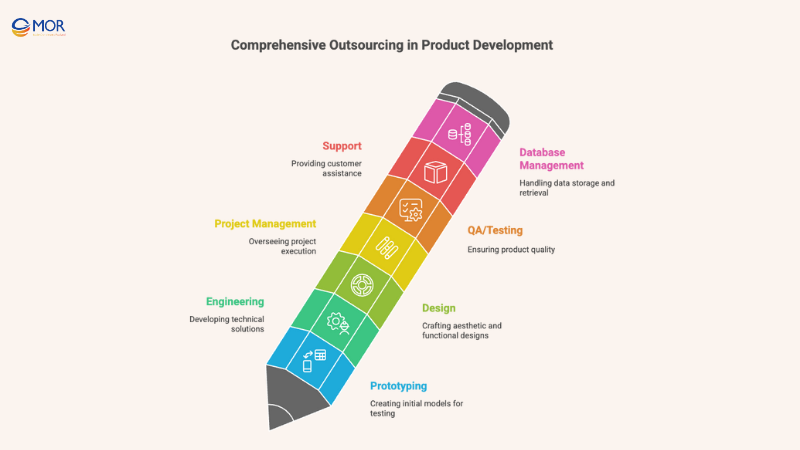
You can outsource everything from ideation to post-launch support, including:
- Product prototyping
- End-to-end product engineering
- Product design
- Product architecture
- Custom product development
- Mobile app development tools
- Web application development
- Complete project management
- Quality assurance and testing
- Hardware support and upgrades
- Performance monitoring and optimization
- Technical support and troubleshooting
- Database management and backup
Understood. Here’s the revised version without inserting the long-tail keyword:
Whether you’re building a new SaaS platform or modernizing an existing solution, partners in Vietnam, Eastern Europe, or similar regions often cover all these areas under one roof. That kind of breadth makes outsourced product development a smart option when you want speed, quality, and coverage, all without hiring multiple vendors.
That level of coverage is great but it only works if you choose the right team from the start.
How To Choose the Right Outsourced Product Development Team?
Choosing the right outsourced product development partner plays a big role in whether your project succeeds or stalls. You need a team that matches your goals, understands your standards, and fits your work style.
Here are 10 practical steps to help you find the right outsourcing company.
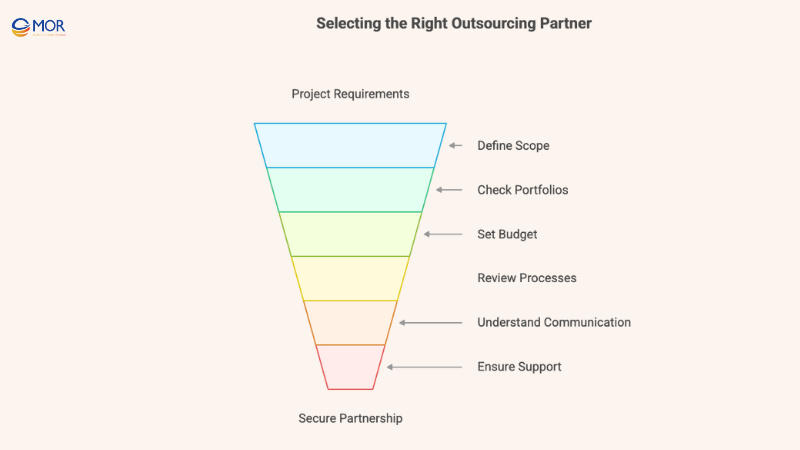
Clearly Define the Scope
Before reaching out to any vendor, map out exactly what you want. A detailed scope should outline your goals, deliverables, features, and deadlines. It sets the baseline for communication and keeps everyone on the same page.
You’ll also want a proper spec doc. Include system requirements, UX flows, tech stacks, and expected outcomes. This helps avoid misunderstandings and scope creep down the line.
Clarity at this stage makes outsourced product development way more efficient. It also shows partners you’re serious, and prepared.
Check Portfolios and Reviews
Not all vendors are created equal. You need to dig into their work history. Look for past projects that mirror your own, and read client reviews to understand how they work.
A solid outsourced product development company will proudly share real case studies and client feedback. If they’ve built apps or platforms in your industry before, that’s a big plus. Strong portfolios speak louder than polished pitches.
Set a Realistic Budget
Budget planning isn’t just about numbers. It’s also about setting expectations, for both cost and quality.
Your budget shapes the kind of talent you can hire. A higher range might get you a senior architect, while a tighter one might mean working with a mid-level dev. Either way, transparency helps vendors propose the right solution and team size.
Good outsourcing product development starts with clear financial planning. Otherwise, even strong ideas can fall apart.
Review QA and Testing Processes
Ask how the team handles quality assurance. What types of testing do they use? How do they find and fix bugs? Do they track issues through tools like Jira or internal systems?
Strong QA processes are non-negotiable. A partner with reliable testing in place will catch issues early, ship cleaner code, and deliver a better experience for your users.
When working with outsourced product development companies, a solid QA team workflow is a sign they take product quality seriously, not just deadlines.
Understand Their PM and Communication Style
How does the team run projects? Look for experience with Agile, Scrum, or similar frameworks that allow for fast feedback and iteration. These methods help you stay flexible and adapt quickly when things change.
It also matters how you stay in touch. Agree on project tracking tools, like Jira, Asana, or Trello, and choose a communication platform that supports quick updates, like Slack or Microsoft Teams.
You should also clarify meeting frequency, who’s the point of contact, and what happens if something urgent comes up. Clear workflows and good communication make outsourced product development easier to manage and way less stressful.
Use KPIs to Track Progress
Setting clear KPIs helps you measure how well your outsourced product development team is performing. These metrics give both sides a shared view of progress and highlight any areas falling behind.
A few solid KPIs include:
- Sprint burnout: Tracks how much work has been completed versus what’s left
- Kilo lines of code per defect: Helps assess code quality by measuring errors in every 1,000 lines
- Story points completed: Shows how much value the team is delivering per sprint
These data points help you stay on track and spot issues before they snowball. In developer outsourcing, numbers talk. So use them.
Ask About Risk Management Plans
Every project has risks, timeline delays, team turnover, or scope changes. The right partner should already have a plan in place to handle them.
Ask how they manage issues like resource gaps or shifting requirements. What do they do if there’s a security threat or a delay in delivery?
For example, a reliable team might run routine cybersecurity checks or have data recovery processes ready to go. These are signs that your outsourcing IT department partner is serious about protecting your product and reputation.
Confirm They Provide Ongoing Support
Outsourced product development doesn’t stop at launch. Your partner should be ready to handle ongoing updates, bug fixes, and system improvements.
Post-launch maintenance keeps your product aligned with evolving tech and user expectations. It also helps resolve issues fast and keeps things running smoothly.
Look for partners who commit to:
- Routine updates
- Prompt bug fixes
- Feature enhancements
- System checks and performance reviews
This support is especially valuable in outsourced product development services, where your internal team might not have the bandwidth for day-to-day upkeep.
Review Their Knowledge Transfer Plan
What happens if the partnership ends? Make sure your vendor has a clear exit plan and knowledge transfer process.
They should document everything, codebases, architecture, toolchains, and known issues. This ensures your team or future vendors can pick up where they left off.
A proper handover reduces downtime and protects your investment. It’s a crucial part of any outsourced product development agreement, and skipping it can slow you down later.
Get NDAs and IP Ownership in Writing
Before kicking off any outsourced product development project, make sure all legal protections are in place. That starts with clear IP ownership policies and a signed NDA.
These agreements confirm that your product, code, and data belong to you, not the vendor. They also prevent sensitive business info from leaking or being reused elsewhere.
Also, review the IP and data protection laws in your partner’s country. For example, even if your software is patented in the U.S., you might need to register it again if working with vendors in another country. Legal frameworks vary, so it’s best to stay proactive.
Worried about which model works best or how to handle all these steps?
MOR Software makes it simple. As a trusted leader in outsourced product development in Vietnam, we help clients across the U.S., Japan, Germany, South Korea, and Australia succeed with full legal transparency, strong communication, and airtight security.
Compared to many outsourced product development companies, we bring both technical expertise and reliable support across time zones. Whether you need a dedicated team or full-scope development, MOR is ready to build, scale, and secure your product from day one.
When Should Businesses Consider Outsourced Product Development?
There are plenty of situations where outsourced product development makes more sense than building everything in-house. It’s not just about saving time or money, it’s about working smarter.
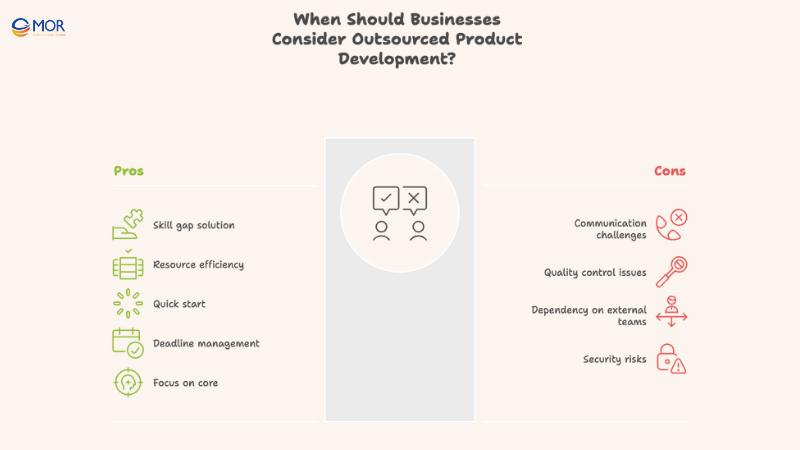
You should consider outsourcing when:
- Your team lacks the technical skills or resources for a project
- You’re dealing with budget or infrastructure constraints
- You want to skip long hiring cycles and get started fast
- You’re racing against a tight deadline
- You’re building a short-term or one-off solution that doesn’t need a full team
- You’re expanding into new markets and need help with compliance
- You’re creating a ready-to-launch solution like an eCommerce site or internal tool
- Your internal developers need to stay focused on core systems or high-priority work
In cases like these, outsourcing product development isn’t just a fallback, it’s a strategic choice. The right partner can fill gaps, deliver faster, and keep your internal team focused on what they do best.
Still asking how this fits your business goals? Let’s dig deeper into what affects cost.
>>> READ MORE: Outsourcing IT to Vietnam: Pros & Cons and How to Get Started in 2025
Key Factors Affecting Outsourced Product Development Costs
Several things shape the total cost of outsourced product development, from who you hire to how long the work takes. Let’s break down the most common cost drivers.
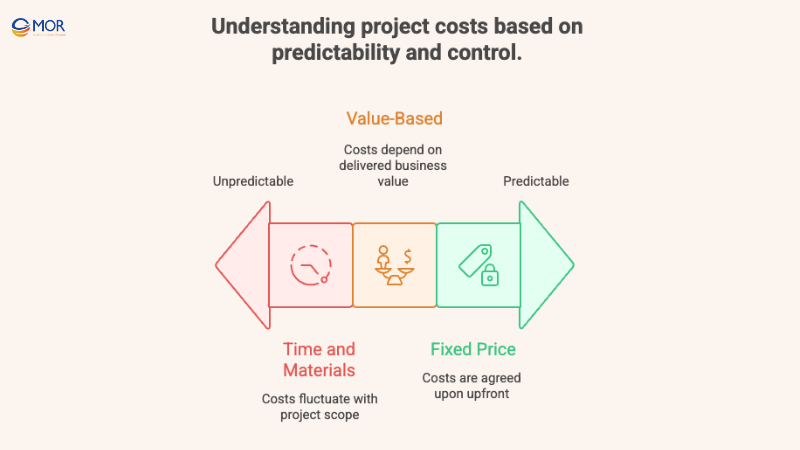
Country and Location
Where your development team is based plays a big role in cost. Different countries have different living expenses, labor rates, and exchange rates, which all impact your bill.
For example, hiring outsourced development team in Vietnam may cost around $800–1,300 USD per month, while the same role in the U.S. could run over $7,600/month. That’s why many companies look to outsourced product development companies in India, Vietnam, or Latin America to stretch their budgets further.
Complexity and Duration of Work
The longer and more technical your project, the higher the cost. Sophisticated builds often require niche skills, extensive testing, and longer delivery timelines.
Let’s say you’re building an AR-based gaming app. That might cost anywhere from $7,000 to $25,000 depending on the scope, features, and tech stack involved. Complexity always raises the bar in software product development outsourcing.
Developer Skills and Experience
Not all developers charge the same. A junior might handle simple coding tasks, but for advanced systems, you’ll need senior-level engineers, and they come at a premium.
In the U.S., a software developer with two years of experience might earn $55,000 per year. With over 10 years on the job? That number jumps to around $116,000. The same logic applies across most outsourcing hubs. More experience means higher rates, but often fewer mistakes and faster delivery.
Your Pricing Model
How you pay for your outsourced product development project will shape your final costs. Each pricing model comes with its own pros and trade-offs.
- Fixed-price model: You and the vendor agree on a set cost upfront. It’s great for budgeting but leaves little room for change once the project kicks off.
- Time and materials model: You’re billed for hours worked and resources used. This model is flexible but can get pricey if the scope grows.
- Value-based pricing: You pay based on the product’s business value or expected ROI. While this model can reward innovation, it’s harder to calculate and negotiate fairly.
Choose based on your goals, timeline, and how much the scope might evolve.
System and Software Integration Needs
Simple integrations, like adding Stripe for payments, are usually quick and low-cost.
But if you’re tying into legacy system, building custom APIs, or syncing with complex tools like Salesforce or HubSpot, expect higher costs. These projects require careful planning and deep technical skills, especially in outsourcing product development for enterprise-grade solutions.
Ongoing Support and Maintenance
Once the product is live, the work isn’t over. You’ll need to keep it running, fix bugs, update features, and monitor performance.
Make sure your budget includes:
- Post-launch bug fixes
- Feature tweaks based on user feedback
- Regular system updates and patches
- Tech support for ongoing user needs
Many businesses forget to factor this in, but it’s a core part of long-term success in outsourced product development.
Of course, no model is perfect. Let’s now look at the common risks you should plan for.
Risks To Watch In Outsourced Product Development
While outsourced product development has plenty of upsides, it’s not without its challenges. Being aware of the risks upfront helps you plan better and avoid headaches later.
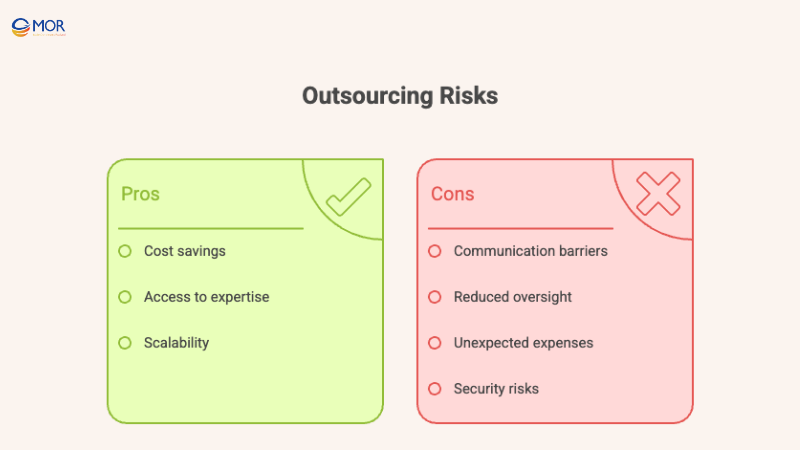
- Language, cultural, and time zone gaps: Working with teams across the globe, especially in offshore software development companies, can lead to communication issues. Language barriers or different work styles can cause confusion. And when teams are on opposite sides of the world, delays can creep in due to limited overlap in working hours.
- Less control over daily management: Remote teams mean you won’t have the same hands-on oversight as you do with in-house staff. Without proper alignment, this can affect trust, project direction, or even product quality. It’s a common challenge with outsourcing product development across long distances.
- Surprise expenses: If your vendor isn’t transparent, you might face unexpected costs. These can include extra training, rushed bug fixes, legal consultations, or added tool licenses. This is why working with trusted outsourced product development companies matters.
- IP security and data protection: Outsourcing often requires sharing confidential info, like codebases, user data, or business logic. Without strong security practices and a clear IP agreement, there’s a risk of data breaches or misuse.
The good news? These risks are manageable. Partnering with a credible team that takes security, communication, and transparency seriously makes all the difference. Next, we’ll show you how MOR Software delivers just that.
Offshore Product Development With MOR Software
MOR Software is one of leading software outsourcing companies in Vietnam, trusted by clients from the US, Japan, Germany, South Korea, Australia, and beyond. We help businesses turn ideas into full-scale digital solutions faster, smarter, and more cost-efficient.
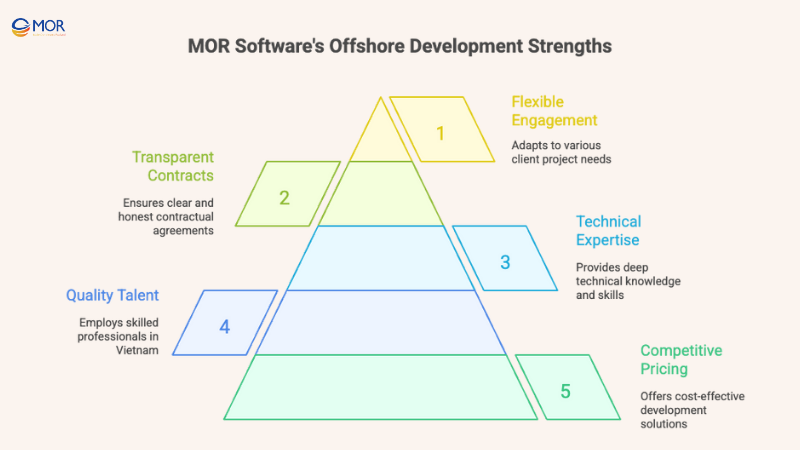
We deliver:
- End-to-end development service for mobile apps, web platforms, salesforce consulting, and embedded systems
- Deep experience in AI, blockchain, QA testing, UI/UX, and long-term maintenance
- Competitive pricing powered by Vietnam’s skilled tech workforce
- High-quality engineers, trained in Agile/Scrum and fluent in English, Japanese, or Korean
- Transparent contracts with full IP protection and clean code handover
- Flexible models: dedicated teams, project-based outsourcing, or staff extension
Whether you're scaling a product, upgrading legacy systems, or launching from scratch, MOR Software builds it right from day one. Contact us to get started.
Conclusion
Outsourced product development isn’t just a cost-saving tactic. It’s a smart way to move faster, work smarter, and bring better products to market. Whether you're short on talent, racing a deadline, or launching something new, the right partner can help you scale without the stress. Ready to build something better, faster, and smarter? Contact us today.
MOR SOFTWARE
Frequently Asked Questions (FAQs)
What is outsourced product development?
It’s the practice of hiring an external company to handle part or all of your product’s design, development, testing, and support instead of building everything in-house.
Which types of projects are best suited for outsourcing?
Startups building MVPs, companies scaling quickly, or teams lacking internal expertise often outsource projects like mobile apps, SaaS platforms, or complex backend systems.
How do I choose the right outsourced development partner?
Check their technical skills, past projects, communication practices, security policies, and how well they understand your business goals.
Can I still stay involved in the development process?
Yes. Most teams work in sprints and share regular updates, so you can review progress, give feedback, and stay fully informed throughout the project.
What are the risks of outsourced product development?
Risks may include misaligned expectations, time zone delays, or IP concerns. These can be minimized with detailed contracts, clear communication, and project tracking tools.
Rate this article
0
over 5.0 based on 0 reviews
Your rating on this news:
Name
*Email
*Write your comment
*Send your comment
1